
Aortic Valve Replacement ICD-10-CM Codes
Read this short guide to learn about Aortic Valve Replacement ICD codes you can use!
Use Code
Commonly asked questions
No. Once the aortic valve gets damaged, replacing it is the only way to address it before it becomes a problem.
As with any surgical procedure, healthcare professionals will inform patients about the risks, which include the following: infections, the formation of blood clots, stroke, and arrhythmia. There is also a 2% chance of death.
Two to three months. Patients can resume normal activities after six weeks post-procedure, but it’s best to follow whatever advice the doctors give, especially what to avoid doing and consuming.
EHR and practice management software
Get started for free
*No credit card required
Free
$0/usd
Unlimited clients
Telehealth
1GB of storage
Client portal text
Automated billing and online payments
